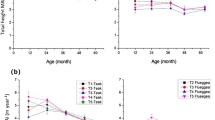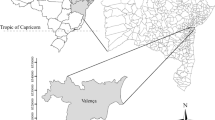Abstract
Improved knowledge of canopy processes is allowing better estimation of the influence of forests in hydrology for forest function. The societal demand for timber wood has increased rapidly in the last two decades. The best genetic selection of teak (Tectona grandis L.) has been found and produced with shoot cuttings or tissue cultures and planted in Central Java, Indonesia. Understanding the hydrological processes in a teak plantation is helpful to develop a strategy for sustainable forest management system. The aim of this study was to measure the hydrological processes of canopy interception and direct runoff to estimate the forest interception in two types of the teak plantation. Two paired catchment experiments were established to monitor the canopy interception and direct runoff during the rainy season. Catchment T1 was planted with 10-year-old superior teak, and catchment T2 was planted with 10-year-old conventional teak. Superior teak is the result of tree improvement from prospective clonals of teak. Superior teak is propagated by shoot cutting or tissue cultures, while the conventional teak is from seed production in seed orchards. Canopy interception was investigated using 15 units of throughfall and eight units of stemflow in both catchments. The two catchment experiments were equipped with sharp-crested 900 V-notch weirs and automatic water level recorders. The percentage ratio between stemflow and throughfall in the T1 and T2 catchments were 0.08:54.7 and 0.15:70.4 of rainfall. The canopy interceptions in the T1 and T2 catchments were 45.2% and 29.4% of rainfall. Direct runoff in the T1 and T2 catchments were 32.2% and 47.2% of rainfall. Forest interceptions as a function of canopy interception and forest floor interception in the T1 and T2 catchments were 58.2% and 33.1% of rainfall. The difference in forest canopy cover of 13% has led to changes in the canopy interception. This change has affected an increase in the direct runoff and forest interception in the catchment. Characteristics of superior teak with fast growth and uniform physical appearance of diameter, height, and canopy structure showed higher forest interception than that of the conventional teak.
Access this chapter
Tax calculation will be finalised at checkout
Purchases are for personal use only
Similar content being viewed by others
References
Abdulhadi R, Kartawinata K, Sukardjo S (1981) Effects of mechanized logging in the lowland dipterocarps Forest at Lempake, East Kalimantan. The Malaysian Forester 44:407–418
Bent GC (2001) Effects of Forest-management activities on runoff components and ground-water recharge to Quabbin reservoir, Central Massachusetts. For Ecol Manag 143:115–129
Bosch JM, Hewlett JD (1982) A review of catchment experiments to determine the effect of vegetation changes on water yield and evapotranspiration. J Hydrol 55:3–23
Chang M (2006) Forest hydrology, an introduction to water and forests, Second edn. CRC Press, U.S.A., pp 201–210
Lanea PNJ, Mackay SM (2001) Streamflow response of mixed-species eucalypt forests to patch cutting and thinning treatments. For Ecol Manag 143:131–142
Liu Y, An S, Deng Z, Fan N, Yang H, Wang Z, Zhi Y, Zhou C, Liu S (2006) Effects of vegetation patterns on yields of the surface and subsurface waters in the Heishui Alpine Valley in west China. Hydrol Earth Syst Sci Discuss 3:1021–1043
Osuji GE, Okon MA, Chukwuma MC, Nwarie II (2010) Infiltration characteristics of soils under selected land use practices in Owerri, southeastern Nigeria. World Journal of Agricultural Sciences 6(3):322–326
Suryatmojo H (2014) Recovery of Forest soil disturbance in the intensive Forest management system. Procedia Environ Sci 20., Elsevier:832–840
Suryatmojo H, Fujimoto M, Kosugi K, Mizuyama T (2014) Runoff and soil erosion characteristics in different periods of an intensive forest management system in a tropical Indonesian rainforest. International Journal of Development and Planning 9(6):830–846
Zhang L, Dawes WR, Walker GR (1999) Predicting the effect of vegetation changes on catchment average water balance. Cooperative Research Centre for Catchment Hydrology. CSIRO Land and Water, Clayton
Zhao FF, Zhang L, Xu ZX (2009). Effects of vegetation cover change on streamflow at a range of spatial scales. In: 18th World IMACS/MODSIM Congress, Cairns, Australia 13–17 July 2009
Author information
Authors and Affiliations
Corresponding author
Editor information
Editors and Affiliations
Rights and permissions
Copyright information
© 2018 Springer Nature Singapore Pte Ltd.
About this chapter
Cite this chapter
Suryatmojo, H., Imron, M.A. (2018). Hydrological Processes in Different Types of Teak (Tectona grandis L.) Plantation. In: McLellan, B. (eds) Sustainable Future for Human Security . Springer, Singapore. https://doi.org/10.1007/978-981-10-5430-3_2
Download citation
DOI: https://doi.org/10.1007/978-981-10-5430-3_2
Published:
Publisher Name: Springer, Singapore
Print ISBN: 978-981-10-5429-7
Online ISBN: 978-981-10-5430-3
eBook Packages: Earth and Environmental ScienceEarth and Environmental Science (R0)




